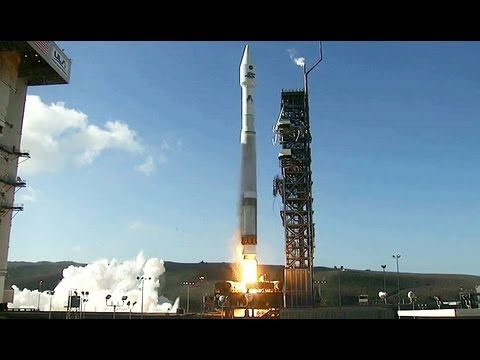more at
Public domain film from NASA.
LDCM Overview
The Landsat Data Continuity Mission (LDCM) is a collaboration between NASA and the U.S. Geological Survey that will continue the Landsat Program’s 40-year data record of monitoring Earth’s landscapes from space. LDCM will expand and improve on that record with observations that advance a wide range of Earth sciences and contribute to the management of agriculture, water and forest resources.
The Landsat Program is a series of Earth-observing satellite missions jointly managed by NASA and the U.S. Geological Survey. The first Landsat satellite launched in 1972 and the next satellite in the series, the Landsat Data Continuity Mission — LDCM, is scheduled to launch on February 11, 2013.
Atlas V is an active expendable launch system in the Atlas rocket family. Atlas V was formerly operated by Lockheed Martin, and is now operated by the Lockheed Martin-Boeing joint venture United Launch Alliance. Each Atlas V rocket uses a Russian-built RD-180 engine burning kerosene and liquid oxygen to power its first stage and an American-built RL10 engine burning liquid hydrogen and liquid oxygen to power its Centaur upper stage. The RD-180 engines are provided by RD AMROSS and the RL10 engines by Pratt & Whitney Rocketdyne. Some configurations also use strap-on booster rockets made by Aerojet. The standard payload fairing sizes are 4 or 5 meters in diameter and of various lengths, are made by RUAG Space. Fairings sizes as large as 7.2m in diameter and up to 32.3m in length have been considered. The rocket is assembled in Decatur, Alabama; Harlingen, Texas; San Diego, California; and at United Launch Alliance’s headquarters near Denver, Colorado.
In its more than two dozen launches, starting with its maiden launch in August 2002, Atlas V has had a near-perfect success rate. One flight on June 15, 2007, NRO L-30, experienced an upper-stage anomaly when the engine in the vehicle’s Centaur upper stage shut down early, leaving the payload—a pair of ocean surveillance satellites—in a lower than intended orbit. However, the customer, the National Reconnaissance Office, categorized the mission as a success…
Centaur is a rocket stage designed for use as the upper stage of space launch vehicles. Centaur boosts its satellite payload to geosynchronous orbit or, in the case of an interplanetary space probe, to or near to escape velocity. Centaur was the world’s first high-energy upper stage, burning liquid hydrogen (LH2) and liquid oxygen (LOX).
Centaur, named after the centaurs of Greek mythology, was the brainchild of Karel J. “Charlie” Bossart (the man behind the Atlas ICBM) and Dr. Krafft A. Ehricke, both Convair employees. Their design was essentially a smaller version of the Atlas, with its concept of using lightweight “stainless steel balloon” tanks whose structural rigidity was provided solely by the pressure of the propellants within. To keep the tanks from collapsing prior to propellant loading, they were either kept in “stretch” or pressurized with nitrogen gas.
Centaur uses a common double-bulkhead to separate the LOX and LH2 tanks. The two stainless steel skins are separated by a 0.25 inch (6.4 mm) layer of fiberglass honeycomb. The extreme cold of the LH2 on one side creates a vacuum within the fiberglass layer, giving the bulkhead a low thermal conductivity, and thus preventing heat transfer from the relatively warm LOX to the super cold LH2. It is powered by one or two RL10 rocket engines (SEC and DEC variants respectively)…

